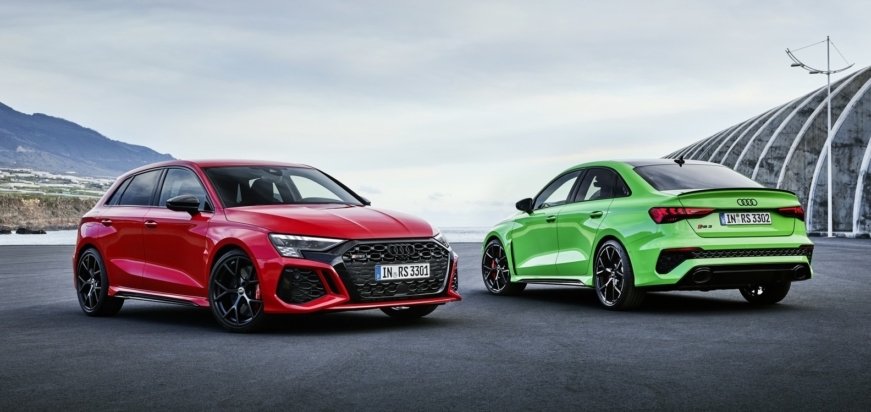Audi has ushered in a raft of design, technology and powertrain upgrades for the new, third-generation version of its hardcore RS3 mega-hatch.
Revealed in hatchback and saloon forms, the RS3 will go on sale in August, priced from £50,900 and £51,900, respectively, with the first customer deliveries due towards the end of the year.
Powertrain
Audi’s venerable 2.5-litre turbocharged five-pot motor, named an International Engine of the Year on nine consecutive occasions, returns for the new arrival. As in the RS3’s larger RS Q3 sibling, it sends 395bhp through a seven-speed dual-clutch gearbox to both axles. That’s sufficient to propel both the hatchback and saloon from standstill to 62mph in just 3.8sec and to an optional maximum speed of 174mph – figures that just edge Mercedes-AMG’s 416bhp A45 S 4Matic for outright pace.
With 369lb ft of torque – 20lb ft more than the old car – available at 2250- 5600rpm, the new RS3 is claimed to accelerate “even faster from low ranges” than its predecessor. Its maximum power output is available over a wider rev band, too.
Audi also highlights the “incomparable sound” provided by the motor’s unique 1-2-4-5-3 cylinder firing order, with a new noise-control flap in the exhaust opening at different points in the rev range according to the selected driving mode and an optional RS sports exhaust available for an “enhanced” engine note.
Chassis
New for the third-gen RS3 is a torque splitter device, replacing the old car’s rear differential, which comprises a pair of electronically controlled multi-disc clutches to better distribute power across the rear axle. As well as reducing understeer under hard cornering, the new technology allows for “controlled drifts” in RS Torque Rear mode by sending up to 1291lb ft of torque to each rear wheel as required.
Chassis upgrades over the old car extend to more responsive shock absorbers with an RS3-specific valve system, increased wheel camber for more precise steering and a modular vehicle dynamics controller (mVDC), which monitors lateral movement across drivetrain and suspension components to better modulate torque output.
The new RS3 gets a larger set of six-piston brake calipers, mated with ventilated and drilled discs on each axle that are claimed to be larger and more stable than the previous car’s, with cooling enhanced by 20%. Ceramic brake discs are available on the front axle, with the brake pedal curve tuned to match their boosted performance and the option of grey, red, blue or black calipers.
In some markets, Audi will offer the RS3 with semi-slick tyres for improved on-track performance, but this is not an option in the UK.
Design
In keeping with tradition, the RS version of Audi’s family hatchback makes itself known by way of added air intakes, bespoke performance wheels, a larger exhaust and more aggressive styling cues.
For this generation in particular, Audi has sought to differentiate the RS3 from the regular A3 by giving the hot model a bespoke front end design comprising a contrasting black grille surround (either matt or gloss) that extends into the headlight clusters, which themselves are optionally available as matrix LED items with darkened bezels. The side skirts are finished in black, too, as are the wing mirrors, rear diffuser and, optionally, the roof.
Meanwhile, behind the flared front wheel arches is a new outlet that directs air along the side of the car. The axle track has also been extended over the old car’s by 33mm at the front and 10mm at the rear for improved handling and a wider stance.
Two new colours are available for the RS3: Kyalami Green (as seen here) and Kemora Grey.
It’s a similar treatment inside, where the general layout of the standard car is carried over but with a number of design flourishes to promote the RS3’s performance credentials. The instrument panel is made of carbonfibre, for example, and the sports seats are optionally upholstered in nappa leather with black, red or green contrasting stitching.
A 12.3in digital display is standard and features RS-specific tachometer and power usage graphics – including an ‘RS Runway’ design, which presents data “in a manner that visually resembles an airplane runway”, said Audi.
A motorsport-style gearshift indicator also features and the 10.1in infotainment touchscreen can display an ‘RS Monitor’ showing coolant, engine and gearbox oil temperatures, as well as tyre pressures.

